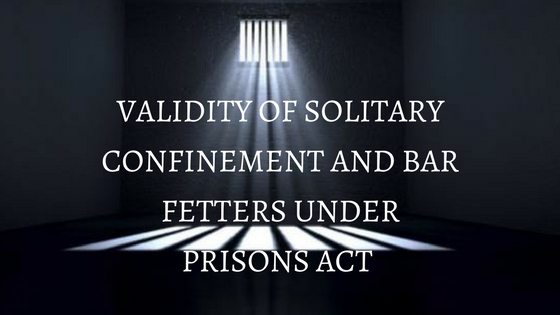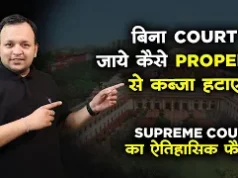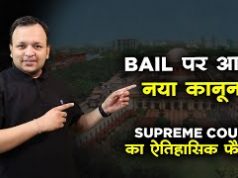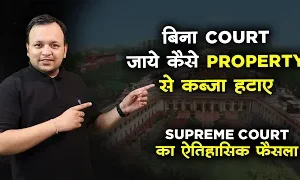Aapka Consultant Judgment Series- In this series, we are providing case analysis of Landmark Judgments of Hon’ble Supreme Court of India.
Sunil Batra Vs. Delhi Administration and Ors. etc.
AIR 1980 SC 1579, 1978 CriLJ 1741, 1980 CriLJ 1099, (1978) 4 SCC 494, (1980) 3 SCC 488, (1979) SCC(Cri) 155, (1980) SCC(Cri) 580, [1979] 1 SCR 392, [1980] 2 SCR 557
Hon’ble Judges/Coram: D.A. Desai, JJ, Y.V. Chandrachud, C.J., V.R. Krishna Iyer, S. Murtaza Fazal Ali and P.N. Singhal.
Date of Decision: 30.08.1978
FACTS: –
Section 30(2) of the Prisons Act provides that every prisoner under sentence of death shall be confined in a cell apart from all other prisoners and shall be placed by day and by night under the charge of a guard. The petitioner who was a convict under sentence of death challenged his solitary confinement. It was contended on his behalf that s. 30(2) does not authorise placing a prisoner under sentence of death in solitary confinement and that the jail authority could not arrogate to itself the power to impose such punishment under the garb of giving effect to s. 30(2). On the other hand it was contended on behalf of the State that the section merely permits statutory segregation for safety of the prisoner in the prisoner’s own interest and that instead of striking down the provision, the Court should adopt a course of so reading down the section as to denude it of its ugly inhuman features.
Another petitioner, Charles Sobhraj in a different writ petition contended that s. 56 of the Prisons Act which confers unguided, uncanalised, and arbitrary powers on the Superintendent to confine a prisoner in irons is ultra vires Articles 14 and 21 of the Constitution.
ISSUES: –
- Whether Section 30(2) of the Prisons Act is constitutional or not?
- Whether Section 56 of the Prison Act is ultra vires of the Indian Constitution?
JUDGMENT: –
Section 30(2) does not empower the prison authority to impose solitary confinement upon a prisoner under sentence of death. Even jail discipline inhibits solitary confinement as a measure of jail punishment. It has been well established that convicts are not by mere reason of the conviction denuded of all the fundamental rights which they otherwise possess. Even a convict is entitled to the precious right guaranteed by Article 21 that he shall not be deprived of his life or personal liberty except according to the procedure established by law.
Sections 73 and 74 of the Indian Penal Code leave no room for doubt that solitary confinement is by itself a substantive punishment which can be imposed by a court of law. It cannot be left to the whim and caprice of prison authorities. The limit of solitary confinement that can be imposed under Court‘s order is strictly prescribed by the Penal Code. Solitary confinement is so revolting to the modern sociologist and law reformer that the Law Commission recommended that the punishment of solitary confinement is out of tune with modern thinking and should not find a place in the Penal Code as a punishment to be ordered by any criminal court even though it may be necessary as a measure of jail discipline. The explanation to s. 44(8) of the Prisons Act makes it clear that a person is not wholly segregated from other prisoners in that he is not removed from the sight of other prisoners and he is entitled to have his meals in association with one or more other prisoners. Even such separate confinement cannot exceed three months. Para 84 the Punjab Jail Manual, if literally enforced would keep a prisoner totally out of bounds, that is, beyond sight and sound. Neither separate confinement nor cellular confinement of a condemned prisoner would be as tortuous or horrendous as solitary confinement of a condemned prisoner.
Section 30(2) merely provides for confinement of a prisoner under sentence of death in a cell apart from other prisoners. Such confinement can neither be cellular confinement nor separate confinement and in any event it cannot be solitary confinement. A “prisoner under sentence of death” in the context of s. 30(2) can only mean a prisoner whose sentence of death has become final, conclusive and indefeasible which cannot be annulled or avoided by any judicial or constitutional procedure. Till then a person who is awarded capital punishment can be said to be a prisoner under sentence of death. There is an inordinate time lag between the sentence of death passed by the Sessions Judge and the final disposal of appeal by the High Court or Supreme Court depending on the circumstances of each case or the rejection of an application for mercy by the President or the Governor. It cannot be said that under s. 30(2) such prisoner, from the time the death sentence is awarded by the Sessions Judge has to be confined to a call apart from other prisoners.
Jail custody is something different from custody of a convict suffering simple or rigorous imprisonment. The purpose behind enacting s. 366(2) of the Code of Criminal Procedure is to make the prisoner available when the sentence is required to be executed. Unless special circumstances exist, even in cases where a person is kept in a cell apart from other prisoners with day and night watch, he must be within the sight an sound of other prisoners and be able to take food in their company. Section 30(2) as interpreted is not violative of Art. 20. When a prisoner is committed under a warrant for jail custody under s. 366(2), Cr. P.C. and if he is detained in solitary confinement which is a punishment prescribed by s. 73, I.P.C. it will amount to imposing punishment for the same offence more than once, which would be violative of Art. 20(2). But as the prisoner is not to be kept in solitary confinement and the custody in which he is kept under s. 30(2) would prelude detention in solitary confinement, there is no chance of imposing a second punishment upon him and, therefore, s. 30(2) is not violative of Art. 20.
Personal liberty of the person who is incarcerated is to a great extent curtailed by plaintive detention. It is even curtailed in preventive detention. The liberty to move, mix, mingle, talk, share company with co-prisoners, if substantially curtailed, would be violative of Article 21 unless the curtailment has the backing of law. Section 30(2) establishes the procedure by which it can be curtailed but it must be read subject to the interpretation placed in this judgment.
Classification according to sentence for security purposes is valid and therefore s. 30(2) does not violate Art. 14. The restriction imposed by s. 30(2) is not unreasonable. It is imposed keeping in view the safety of the prisoner and the prison security and does not violate Art. 19. There is no warrant for an implicit belief that every prisoner under sentence of death is necessarily violent or dangerous requiring his segregation. The rationale underlying s. 30(2) is that the very nature of the position and predicament of a prisoner under sentence of death leads to a certain situation and present problems peculiar to such persons and warrant their separate classification and treatment as a measure of jail administration and prison discipline. Section 30(2) as interpreted does not mean that the prisoner is to be completely segregated except in extreme cases of necessity which must be specifically made out and that too after he become a prisoner under sentence of death.
Section 56 is not violative of Articles 14 and 21. The power under section 56 can be exercised only for reasons and considerations which are germane to the objective of the statute, viz.: safe custody of the prisoner, which takes in considerations regarding the character and propensities of the prisoner. These and similar considerations bear direct nexus with the safe custody of prisoners as they are aimed primarily at preventing their escape. The determination of the necessity to put a prisoner in bar fetters has to be made after application of mind to the peculiar and special characteristics of each individual prisoner. The nature and length of sentence or the magnitude of the crime committed by the prisoner are not relevant for the purpose of determining that question. There are sufficient guidelines in section 56. It contains a number of safe guards against misuse of bar fetters by the Superintendent. Such circumscribed peripheral discretion with duty to give reasons which are revisable by the higher authority cannot be described as arbitrary so as to be violative of Art. 14. The Superintendent can put the prisoner in bar fetters only after taking into consideration the peculiar and special characteristics of each individual prisoner. No ordinary routine reasons can be sufficient. Duty to record reasons in the Superintendent‘s journal as well as the prisoner‘s history ticket will narrow the discretionary power conferred on him. The reasons must be recorded in the language intelligible and understandable by the prisoner. A further obligation is that the fetters imposed for the security, shall be removed by the Superintendent as soon as he is of opinion that this can be done with safety.
The Superintendent will have to review the case at regular and frequent intervals for ascertaining whether the fetters can be removed. Moreover the section does not permit the use of bar fetters for an unusually long period, day and night, and that too when the prisoner is confined in a secure cell from where escape is somewhat inconceivable.
HELD: –
Section 30(2) and 56 of the Prisons Act is not unconstitutional and subject to the interpretation made by this court in this case. Prison Authorities do not have unrestricted discretion in using these provisions; their discretion has to be exercised by them after taking into account relevant factors.
To Get Legal Opinion from Advocates/ Legal Experts, Please click here
To Get Legal Opinion from Retired Hon’ble Judges, Please click here












